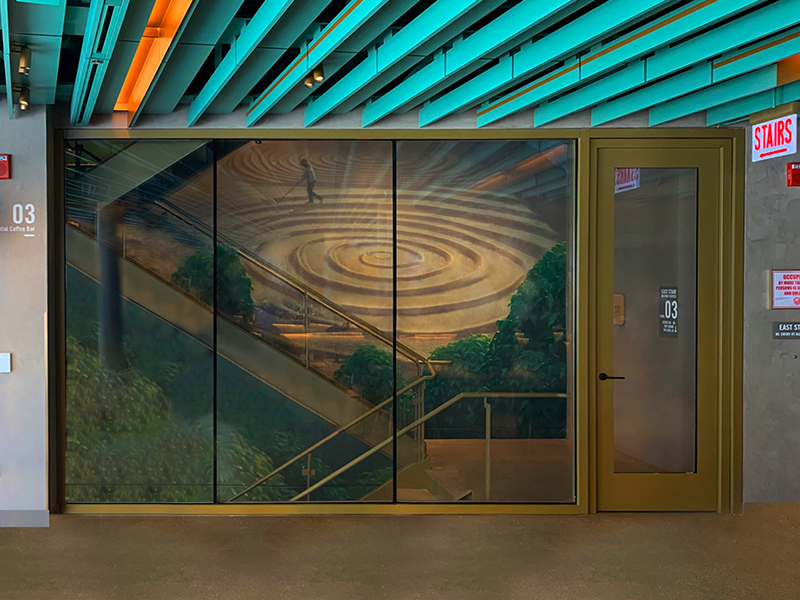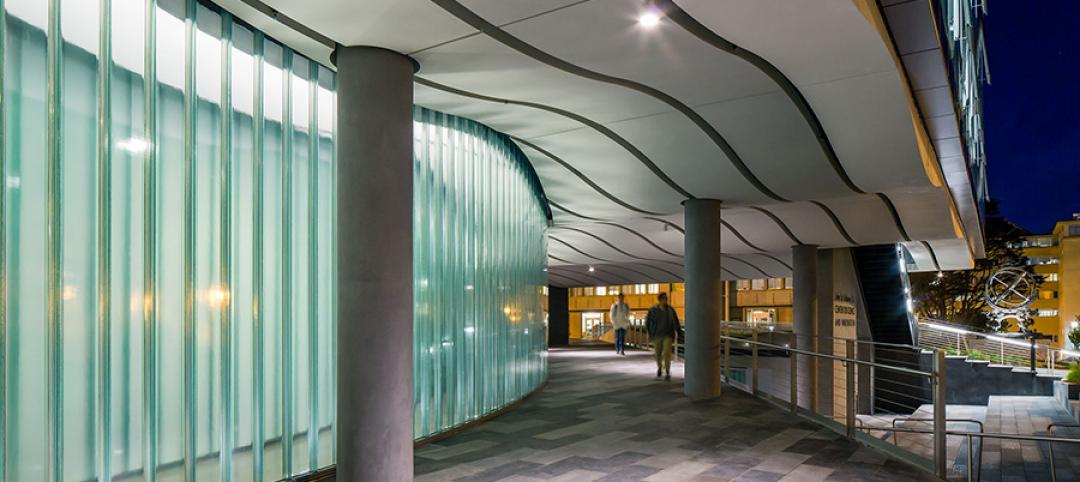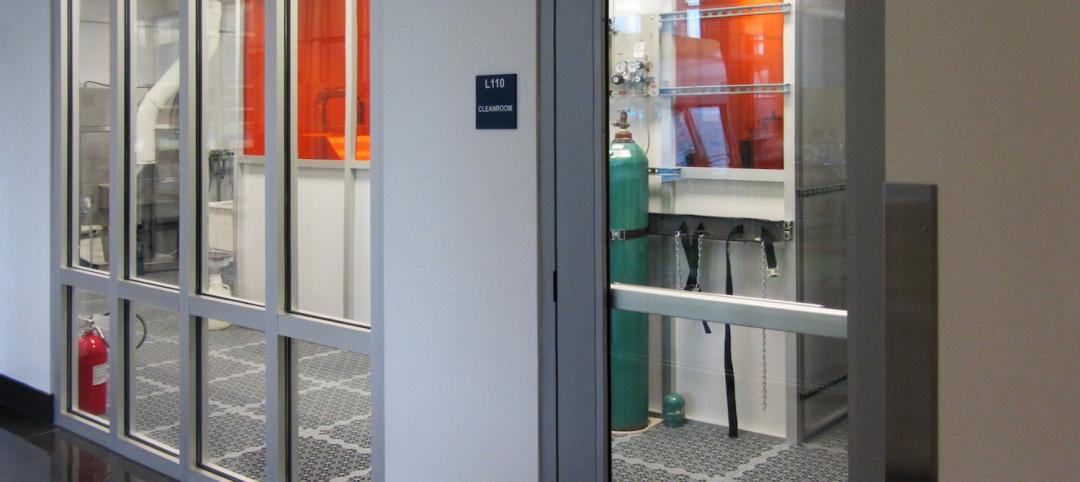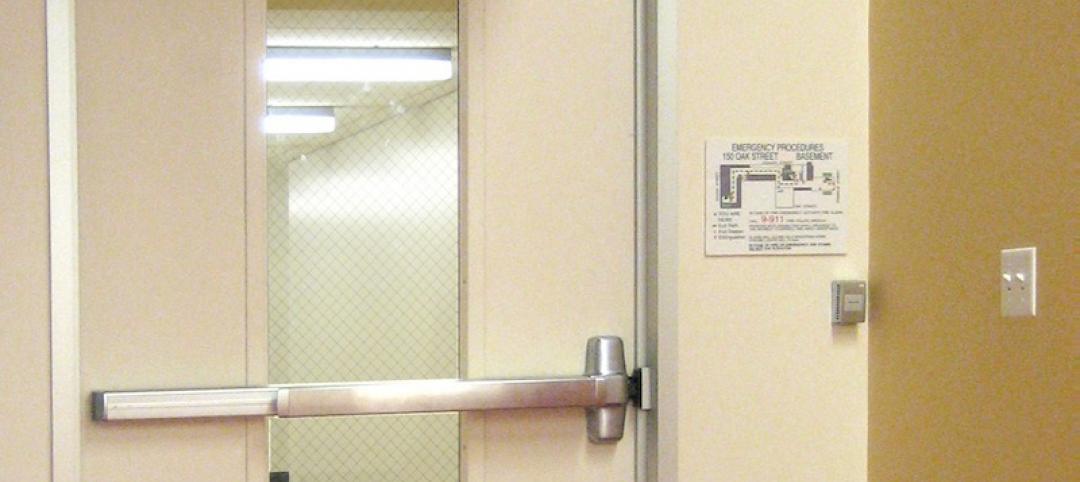The Starbucks Reserve Roastery in Chicago’s Magnificent Mile first opened in November 2019, marking it as the sixth Starbucks roastery globally and the third in the United States. Standing five stories tall, the 35,000 square foot facility is the world’s largest Starbucks. The roastery offers an immersive experience where patrons can ride spiral escalators surrounding a 56-foot cask for 360° views, catch master roasters and baristas impart their vast knowledge on the artistry and science of coffee, and ponder at an incredible, 4-story mural by Chicago artist Eulojio Ortega.
Ortega’s artwork is a progressive piece that pays homage to farmers and coffee-growing regions, exhibiting the art and life of coffee planting, selecting and processing. The mural, brilliant for conveying the story as visitors go from floor to floor, is interestingly located in an exit stairwell.
Traditionally, stairwells are enclosed in opaque walls, leaving them dark, isolated, and rarely utilized unless in an emergency. This is where the architects masterfully blended their creativity with their knowledge of advanced building material technology. To allow the mural to be visible through multiple floors, encourage stair usage and meet fire rated code requirements, the architects redesigned the 2-hour stairwell using transparent, floor-to-ceiling butt-glazed glass walls with the largest tested and listed fire resistive glass panels available.
To meet all the design and code requirements, the architects selected fire resistive, ASTM E-119 rated SuperLite II-XLB 120 by SAFTI FIRST® with Starphire Ultra-Clear glass for its superior optical clarity, large panel sizes and butt-glazing capabilities, which eliminated the need for obstructive vertical mullions for maximum transparency. With the largest individual glass panels over 10’ tall and over 4’ wide, this was easily accommodated by SuperLite II-XLB’s tested and listed size, which is the largest in the industry (133” maximum clear view height or width; 7,980 sq. in. maximum clear view area). As standard glass tends to have a slight blue-green tint from the iron induced from the glass manufacturing process, low-iron Starphire Ultra-Clear glass was used for its superior clarity, improved color neutrality and high visible light transmission – all of which are integral to highlighting the vibrance of Ortega’s artwork and transforming what would have been an ordinary stairwell into a significant element to this Starbucks’s immersive experience.
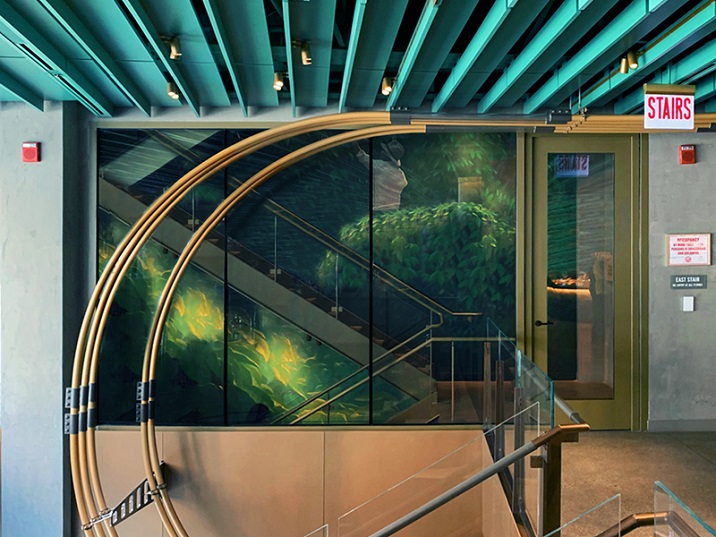
Each floor of this exit stairwell tells a story about coffee-growing, which is on full display thanks to the floor-to-ceiling expanses and butt-glazing capabilities of SuperLite II-XLB 120 with Starphire Ultra-Clear glass for superior clarity.
To ensure transparency and consistent high clarity with the accompanying entrance system, SAFTI FIRST’s GPX® Builders Series Temperature Rise Door was supplied with fire resistive, ASTM E-119 rated SuperLite II-XL 90 with Starphire Ultra-Clear glass in the door vision panel. This allowed architects to exceed the 100 sq. in. door vision panel code limitation that applies to fire protective glazing like ceramics used as vision panels in 60-90 minute temperature rise doors. The GPX Builders Series Temperature Rise Door and surrounding GPX® Architectural Series Perimeter Framing were supplied in a custom finish to blend seamlessly with Starbucks’s bronze palette.
The outcome is a clear, code-compliant stairwell that flaunts Ortega’s masterpiece and transforms ordinary stair-climbing into a truly one-of-a kind Starbucks experience.
Project Name: Starbucks Reserve Roastery in Chicago, IL
Architect: Perkins + Will
General Contractor: Pepper Construction
Glazing Contractor: SG Metal & Glass
Products: SuperLite® II-XLB 120 with Starphire Ultra-Clear® glass in GPX® Architectural Series Perimeter Framing and SuperLite II-XL® 90 with Starphire Ultra-Clear® glass in GPX® Builders Series Temperature Rise Doors
SAFTI FIRST, SuperLite and GPX are registered trademarks owned by SAFTI FIRST.
Starphire Ultra-Clear is a registered trademark owned by Vitro.
Related Stories
| Jul 24, 2014
Glazing options in correctional and detention facilities
Like it or not, the number of incarcerated people in the U.S. continues to rise. With that, increased security in all aspects of these facilities continues to be a priority. This is where security glazing products that allow line of sight for supervisors to observe and still maintain secure separation can play a key role. SPONSORED CONTENT
| Jul 17, 2014
A harmful trade-off many U.S. green buildings make
The Urban Green Council addresses a concern that many "green" buildings in the U.S. have: poor insulation.
| Jul 14, 2014
Foster + Partners unveils triple-glazed tower for RMK headquarters
The London-based firm unveiled plans for the Russian Copper Company's headquarters in Yekaterinburg.
| Jul 7, 2014
5 factors that can affect thermal stress break risk of insulated glass units
The glass type, glass coating, shading patterns, vents, and framing system can impact an IGU’s risk for a thermal break.
Sponsored | | Jul 7, 2014
Channel glass illuminates science at the University of San Francisco
The University of San Francisco’s new John Lo Schiavo Center for Science and Innovation brings science to the forefront of academic life. Its glossy, three-story exterior invites students into the facility, and then flows sleekly down into the hillside where below-grade laboratories and classrooms make efficient use of space on the landlocked campus.
Sponsored | | Jun 27, 2014
SAFTI FIRST Now Offers GPX Framing with Sunshade Connectors
For the Doolittle Maintenance Facility, SAFTI FIRST provided 60 minute, fire resistive wall openings in the exterior using SuperLite II-XL 60 insulated with low-e glazing in GPX Framing with a clear anodized finish.
| May 28, 2014
KPF's dual towers in Turkey will incorporate motifs, symbols of Ottoman Empire
The two-building headquarters for Turkey’s largest and oldest financial institution, Ziraat Bank, is inspired by the country’s cultural heritage.
| May 27, 2014
Fire Rated Glass contributes to open lab environment at JSNN
Openness and transparency were high priorities in the design of the Joint School of Nanoscience & Nanoengineering within the Gateway University Research Park in Greensboro, N.C. Because the facility’s nanobioelectronics clean room houses potentially explosive materials, it needed to be able to contain flames, heat, and smoke in the event of a fire. SPONSORED CONTENT
| May 20, 2014
Kinetic Architecture: New book explores innovations in active façades
The book, co-authored by Arup's Russell Fortmeyer, illustrates the various ways architects, consultants, and engineers approach energy and comfort by manipulating air, water, and light through the layers of passive and active building envelope systems.
| May 5, 2014
Tragic wired glass injury makes headlines yet again
In the story, a high school student pushed open a hallway door glazed with wired glass. His arm not only broke the glass, but penetrated it, causing severe injuries. SPONSORED CONTENT


